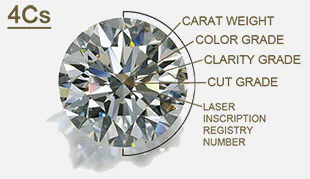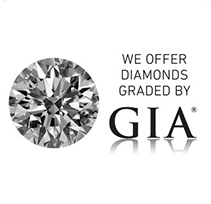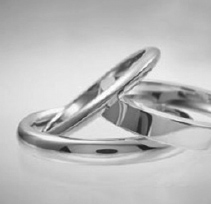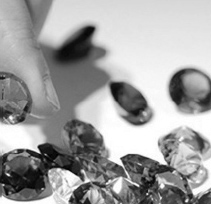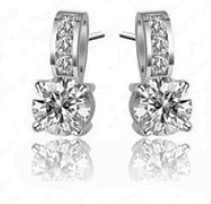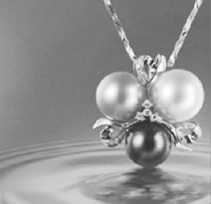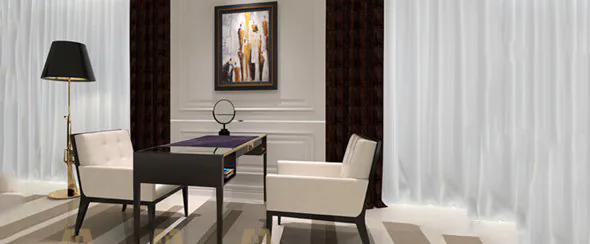RINGS
EDUCATION
Thousands of couples around the world have trusted us with their most important moments. With the largest selection of diamonds and meticulously designed, handcrafted rings, were here to help you find your way to the perfect ring.
DIAMOND
EDUCATION
For most people, buying a diamond is a new experience, but that doesn't mean it should be overwhelming. Understanding a diamond's quality characteristics is straightforward and simple.
Our diamond education is designed to answer all your questions. In just a few minutes you'll know everything you need to know to find your perfect diamond.
JEWELLERY
EDUCATION
it is our mission to take the mystery out of your purchase by offering only the finest quality fine jewellery available, along with expert guidance and education. Our jewellery is crafted with superior materials and inspected against exceptional quality standards.
PEARL
EDUCATION
Use this guide to find the pearl that is right for you by educating yourself on the quality and value of the cultured pearls that we offer.
GEMSTONE
EDUCATION
Gemstones and rare minerals can evoke strong emotions and spur intrigue. While most loose gemstones and minerals are purchased for ornamental jewellery purposes, others are possessed for their fascinating attributes. Natural gemstones and minerals add sparkle to our lives and invigorate our soul with the earth's natural beauty.
DIAMOND SHAPE
We apply the same high quality standards to all of our diamond shapes. We have an exceptional collection of traditional round diamonds and we also offer the finest non-round, or "fancy-shaped", diamonds available. All of our certified diamonds are graded by the GIA or AGSL to have FL-SI2 clarity, D-J color, and Ideal, Very Good, Good, or Fair cut. Our Signature Diamonds are the finest quality diamonds available, and we offer them in round, princess-cut, Asscher-cut, and emerald-cut shapes.
Choose Your Diamond Shape
Since all diamond shapes are very different, unique characteristics determine quality for each shape. Select your shape below to learn how to recognize the most beautiful diamond. If you have additional questions, feel free to contact one of our Diamond and Jewelry Consultants who can help you find the diamond that's perfect for you.








Round
The round brilliant cut diamond is by far the most popular and most researched diamond shape available today. For almost 100 years, diamond cutters have been using advanced theories of light behavior and precise mathematical calculations to optimize the fire and brilliance in a round diamond. In addition to being the most popular and researched shape, a round diamond will typically give you more flexibility in terms of balancing cut, color, and clarity grades while still getting the fire and brilliance you want.
To maximize the brilliance of a traditional round diamond, select one in the two highest cut grades, ideal or very good, and choose ideal, excellent, or very good polish and symmetry grades.
Princess
This is our most popular non-round diamond. Its beautiful brilliance and unique cut makes it a favorite for engagement rings. The princess has pointed corners and is traditionally square in shape. When choosing a color grade, consider that while the price of a J-color non-round diamond is exceptional, color may be slightly visible in its corners. Also, princess-cut diamonds can vary greatly in how square or rectangular they are. To find the dimension of princess you want, look for the length-to-width ratio in our interactive diamond search and on each diamond's detail page. This will determine what the diamond will look like when viewing it from above. Here are length-to-width ratios for princess-cut diamond shapes that are pleasing to the eye.

For a princess diamond shape that is square, look for length-to-width ratios between 1 and 1.05. If you prefer more of a rectangular shape, look for length-to-width ratios greater than 1.10.
Emerald
What makes this shape different is its pavilion, which is cut with rectangular facets to create a unique optical appearance. Due to its larger, open table, this shape highlights the clarity of a diamond. If you choose an emerald-cut with a lower clarity grade, such as SI, be sure to review the clarity plot on the diamond certificate. Also, emerald-cut diamonds can vary greatly in how rectangular they are. If you'd prefer an emerald cut with a squared outline, look for an Asscher-cut diamond. To find the shape of emerald you want, look for the length-to-width ratio in our interactive diamond search and on each diamond's detail page. The length-to-width ratio will determine the diamond's outline, or what it will look like when viewed from the top.
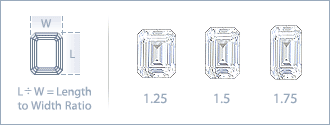
For the classic emerald-cut shape, look for a length-to-width ratio between 1.30 and 1.40.
Marquise
The shape of a marquise diamond can maximize carat weight, giving you a much larger-looking diamond. This brilliant-cut diamond looks beautiful set with round or pear-shaped side stones, and the length of the marquise makes fingers appear long and slender. To find the dimension of marquise you want, look for the length-to-width ratio in our interactive diamond search and on each diamond's detail page. The length-to-width ratio will determine the diamond's outline, or what it will look like when viewed from the top.

For the most traditional marquise-cut diamonds, look for length-to-width ratios between 1.75 and 2.25.
Oval
An oval diamond has beautiful brilliance that's similar to a round diamond. Oval diamonds are also very popular as their length can accentuate long, slender fingers. To find the dimension of oval you want, look for the length-to-width ratio in our interactive diamond search and on each diamond's detail page. The length-to-width ratio will determine the diamond's outline, or what it will look like when viewed from the top.
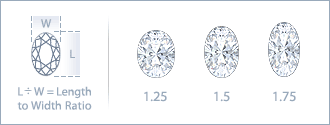
For the most traditional oval diamonds, look for length-to-width ratios between 1.33 and 1.66.
Radiant
Trimmed corners are the signature of this diamond, and they help make the radiant-cut a popular and versatile choice for jewelry. A radiant-cut looks equally beautiful set with either baguette or round side-diamonds. Radiant-cut diamonds can vary in their degree of rectangularity. To find the dimension of radiant you want, look for the length-to-width ratio in our interactive diamond search and on each diamond's detail page. The length-to-width ratio will determine the diamond's outline, or what it will look like when viewed from the top.
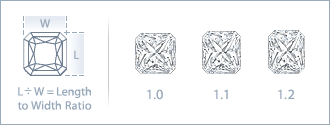
For a radiant diamond shape that is square, look for length-to-width ratios between 1 and 1.05. If you prefer more of a rectangular shape, look for length-to-width ratios greater than 1.10.
Pear
This brilliant-cut diamond is also called a teardrop for its single point and rounded end. The unique look of the pear shape helps make it a popular choice for a variety of diamond jewelry. If you choose an elongated pear shape, the length of the diamond creates a subtle slimming effect on the fingers.
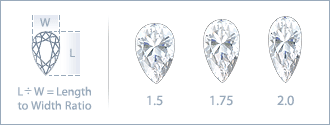
To understand what the diamond will look like when viewing it from above, look for the length-to-width ratio on each diamond's detail page. For the most traditional pear-shaped diamond, look for a length-to-width ratio between 1.45 and 1.75.
Heart
The heart is the ultimate symbol of love. The unique look of the heart-shaped diamond helps make it a distinctive choice for a variety of diamond jewelry. When choosing a color grade, consider that while the price of a J-color heart shaped diamond is exceptional, color may be slightly visible in its corners. To find the dimension of heart-shape you want, look for the length-to-width ratio in our interactive diamond search and on each diamond's detail page. The length-to-width ratio will determine the diamond's outline, or what it will look like when viewed from the top.
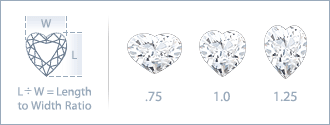
For a more traditional heart-shaped diamond, look for length-to-width ratios between .90 and 1.10.
Cushion
This unique shape has been popular for more than a century. Cushion-cut diamonds (also known as "pillow-cut" diamonds) have rounded corners and larger facets to increase their brilliance. These larger facets highlight the diamond's clarity, so if you choose an SI clarity grade, be sure to review the clarity plot on the diamond certificate. Cushion-cut diamonds are available in shapes ranging from square to rectangular. To find the dimension of cushion you want, look for the length-to-width ratio in our interactive diamond search and on each diamond's detail page. The length-to-width ratio will determine the diamond's outline, or what it will look like when viewed from the top.
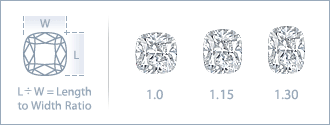
For a cushion-cut diamond that is square, look for length-to-width ratios between 1 and 1.05. If you prefer more of a rectangular shape, look for length-to-width ratios greater than 1.15.










